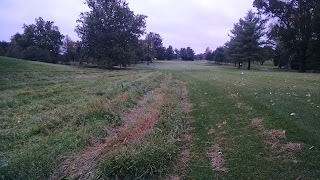As the season winds down, rather than focus on just one
topic this week, the Grounds blog will cover several things that have been
going on in our department.
Work continues on the bunkers on #8. Cleanup of the trash
material is down to the final few loads and sod work will begin in earnest this
week. Sod will be completed as quickly as possible. Right now, our only hold-up
is balancing labor hours between the bunker project and regular course maintenance,
with blowing leaves being our biggest time consumer right now.
Speaking of leaves, we continue to battle the yearly chore
of moving leaves from one place to another so that we can pick them up and get
them off the course. You can read more in-depth about leaf cleanup here.
The last 10 days have seen a great deal of leaves fall because of some of the blustery
days we have had. This is good and bad; good: wind brings the leaves down and
helps to shorten the “leaf” season. Instead of the leaves falling for two and a
half months, the timeframe can be shortened. Bad: trying to move leaves around
when the wind is blowing hard and constantly shifting. Sometimes it seems
futile to even try. And when it is calm enough for us to blow, it usually means
a cold morning.
Cold mornings mean frost. This word is hated by golfers and
maintenance departments alike. Golfers don’t like to be held up and we don’t
like the mad scramble that ensues trying to get the course ready. Click here to
read more about fall frosts in particular. We constantly push to get the course
opened as early as possible. The stressful part, though, is that we are dealing
with a condition that if not handled properly, can actually kill the very grass
we try desperately to keep alive and maintain. Every second and minute counts
for us and the golfers when dealing with frost, too soon and we could have
damage, too late and everyone is frustrated. So far we have had 4 frost delays
this fall, but only one significant one. They will only get worse form here
though, so please be ready on cold mornings.
Lastly, we fertilized greens this past week. Similar
reasoning is involved for fertilizing the greens as was discussed for fertilizing
the rough last week. While the products are different, the science behind
the decision is the same. The greens have come to the end of a long summer and
fall, and are due for some food. We “spoon-feed,” meaning we give tiny amounts
of soluble fertilizer, during the season, but this application is for the
remainder of the year and into spring.
As the seasons change, so do some of our tasks. Instead of
many hours mowing and watering, now we have many hours blowing and working on
projects, but we never run out of things to keep us busy.
Etiquette Reminder of the Month
Please leave bunker rakes inside the bunkers when you are
finished.
Note: Starting in November, through February, posts will be
reduced to once per month. Thank you.
See you on the course!
Joe
jvillegas@bwrc.org









